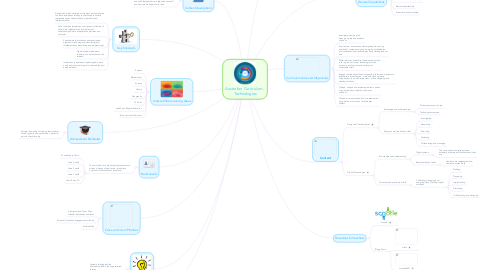
1. Key Concepts
1.1. Abstraction, which underpins all content, particularly the content descriptions relating to the concepts of data representation and specification, algorithms and implementation
1.2. Data collection (properties, sources and collection of data), data representation (symbolism and separation) and data interpretation (patterns and contexts)
1.3. Specification (descriptions and techniques), algorithms (following and describing) and implementation (translating and programming)
1.4. Digital systems (hardware, software, and networks and the internet)
1.5. Interactions (people and digital systems, data and processes) and impacts (sustainability and empowerment).
2. Student Diversity
2.1. The Australian Curriculum allows teachers the flexibly to cater to the diverse range of students needs by personalising their learning.
2.1.1. Students with disability
2.1.2. English as an additional language or dialect
2.1.3. Gifted and talented students
3. Key Ideas
3.1. Systems thinking and the overarching idea: Creating preferred futures
3.2. Project management
4. Cross-curriculum Priorities
4.1. Aboriginal and Torres Strait Islander histories and cultures
4.2. Asia and Australia’s engagement with Asia
4.3. Sustainability
5. Band Levels
5.1. The curriculum for each Technologies subject is written in bands of year levels - provide an overview of the content at each level
5.1.1. Foundation to Year 2
5.1.2. Years 3 and 4
5.1.3. Years 5 and 6
5.1.4. Years 7 and 8
5.1.5. Years 9 and 10.
6. Links to Other Learning Areas
6.1. English
6.2. Mathematics
6.3. Science
6.4. History
6.5. Geography
6.6. The Arts
6.7. Health and Physical Education
6.8. Economics and Business
7. Achievement Standards
7.1. Indicate the quality of learning that students should typically demonstrate by a particular point in their schooling
8. Content descriptions
8.1. These describe the knowledge, understanding and skills that teachers are expected to teach and students are expected to learn
9. General Capabilities
9.1. Literacy
9.2. Numeracy
9.3. Information and communication technology (ICT)
9.4. Critical and creative thinking
9.5. Personal and social capability
9.6. Ethical understanding
9.7. Intercultural understanding
10. Curriculum Aims and Objectives
10.1. Investigate, design, plan, manage, create and evaluate solutions
10.2. Are creative, innovative and enterprising when using traditional, contemporary and emerging technologies, and understand how technologies have developed over time
10.3. Make informed and ethical decisions about the role, impact and use of technologies in the economy, environment and society for a sustainable future
10.4. Engage confidently with and responsibly select and manipulate appropriate technologies − materials, data, systems, components, tools and equipment − when designing and creating solutions
10.5. Critique, analyse and evaluate problems, needs or opportunities to identify and create solutions.
10.6. These aims are extended and complemented by specific aims for each Technologies subject.
11. Content
11.1. Design and Technologies
11.1.1. Knowledge and understanding
11.1.1.1. Technologies and society
11.1.1.2. Technologies contexts
11.1.2. Processes and production skills
11.1.2.1. Investigating
11.1.2.2. Generating
11.1.2.3. Producing
11.1.2.4. Evaluating
11.1.2.5. Collaborating and managing
11.2. Digital Technologies
11.2.1. Knowledge and understanding
11.2.1.1. Digital systems
11.2.1.1.1. The components of digital systems: hardware, software and networks and their use
11.2.1.2. Representation of data
11.2.1.2.1. How data are represented and structured symbolically
11.2.2. Processes and production skills
11.2.2.1. Collecting, managing and analysing data Creating digital solutions
11.2.2.1.1. Defining
11.2.2.1.2. Designing
11.2.2.1.3. Implementing
11.2.2.1.4. Evaluating
11.2.2.1.5. Collaborating and managing
12. Content Elaborations
12.1. illustrate and exemplify what is to be taught and to assist teachers in developing a shared understanding of the content descriptions
13. Resources for teachers
13.1. Scootle
13.2. Blogg Posts
13.2.1. mBot
13.2.2. Hackaball©
